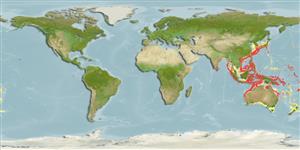Teleostei (teleosts) >
Perciformes/Scorpaenoidei (Scorpionfishes) >
Peristediidae (Armored searobins or armored gurnards)
Etymology: Satyrichthys: Latin, satyrus = a god or demon, partly human and partly bestial, companion of Bacchus + Greek, ichthys = fish (Ref. 45335).
Eponymy: Franz Joseph Friedrich Thaddäus Freiherr von Rieffel (1815–1858) was a government official and politician in Darmstadt, in the Grand Duchy of Hesse, responsible for public finances. [...] (Ref. 128868), visit book page.
More on author: Kaup.
Environment: milieu / climate zone / depth range / distribution range
Ecology
Marine; demersal; depth range 65 - 600 m (Ref. 11230). Deep-water
Western Pacific: Japan, Taiwan, Sea of Japan, southern Pohai Sea, East China Sea, South China Sea, Indonesia and Australia.
Size / Weight / Age
Maturity: Lm ? range ? - ? cm
Max length : 28.0 cm TL male/unsexed; (Ref. 559)
Dorsal spines (total): 7; Dorsal soft rays (total): 17; Anal soft rays: 17. This species is distinguished by the following characters: barbels, 2 on lip and 2 (rarely 1) on the chin; head and body with scattered dusky small spots; upper lateral bony plates of caudal peduncle with antrose spines (Ref. 93228).
Inhabits warm tropical seas along the continental shelf edge and slope and insular areas (Ref. 9771). Benthic (Ref. 75154).
Life cycle and mating behavior
Maturity | Reproduction | Spawning | Eggs | Fecundity | Larvae
Kawai, T., 2013. Revision of the peristediid genus Satyrichthys (Actinopterygii: Teleostei) with the description of a new species, S. milleri sp. nov. Zootaxa 3635(4):419-438. (Ref. 93228)
IUCN Red List Status (Ref. 130435: Version 2024-1)
Threat to humans
Harmless
Human uses
Fisheries: bycatch
Tools
Special reports
Download XML
Internet sources
Estimates based on models
Preferred temperature (Ref.
123201): 11.4 - 22.3, mean 16.3 °C (based on 316 cells).
Phylogenetic diversity index (Ref.
82804): PD
50 = 0.5078 [Uniqueness, from 0.5 = low to 2.0 = high].
Bayesian length-weight: a=0.00646 (0.00301 - 0.01384), b=3.08 (2.89 - 3.27), in cm total length, based on LWR estimates for this (Sub)family-body shape (Ref.
93245).
Trophic level (Ref.
69278): 3.5 ±0.3 se; based on size and trophs of closest relatives
Resilience (Ref.
120179): Medium, minimum population doubling time 1.4 - 4.4 years (Preliminary K or Fecundity.).
Fishing Vulnerability (Ref.
59153): Low vulnerability (18 of 100).
